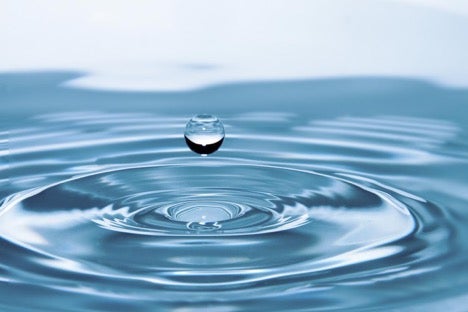
When a female is sexually aroused, the vagina undergoes several physical changes to prepare the female’s body for sexual intercourse. One of the most noticeable changes is an increase in vaginal secretions. The purpose of these secretions is to lubricate the vaginal canal and vaginal opening which makes penetration easier by decreasing friction and thereby irritation.1 As a female becomes sexually aroused, her heart rate quickens and her blood pressure increases which is accompanied by greater blood flow to the genitals. Increased blood flow results in vasocongestion, or the swelling of body tissue caused by increased blood flow and blood pressure.2 The vaginal tissue itself does not contain glands that secrete fluid; however, increased blood pressure in vaginal tissue forces liquid from the blood to seep through the vaginal wall.3 This fluid is called vaginal transudate. Using a camera inserted internally, this fluid can be seen as droplets on the vaginal wall that coalesce to become a film. Vaginal transudate is clear and has a slippery, smooth quality.2 It is primarily responsible for increased wetness during arousal.3
The entrance to the vaginal canal (also called the entroitus) is located in between the labia minora. Two types of glands near the entrance of the vagina secrete mucus that also lubricates the vaginal opening. The first type of gland are the Bartholin glands, or greater vestibular glands. They are located near the entrance of the vagina on either side of the opening. The second type is the Skene glands, or the lesser vestibular glands which are located in close proximity to the vaginal opening near the urethra. The urethra is located just above the vaginal opening.3 The Skene and Bartholin glands only secrete mucus when a female is sexually aroused. The image below shows where the Bartholin glands and their openings are located. The image above shows both the Bartholin glands and Skene glands.
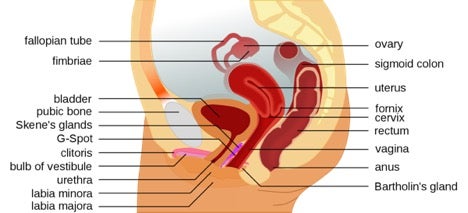
The amount of fluid a female produces when she is aroused varies depending on where she is in her menstrual cycle, her level of arousal, and her age. Different factors also affect how quickly a female becomes naturally lubricated, or “wet,” during sexual arousal. It is common to see lubrication happen quickly in young females in their late teens or early twenties, in the early stages of a relationship, or when she is intensely aroused by something novel.4 Novel stimulation causes arousal in females more rapidly than stimulation she may be accustomed to. When the brain becomes accustomed to a certain level of stimuli, lubrication to happens more slowly.4 There is a great deal of variation between females and the time it takes to become lubricated and the amount of lubrication she produces. Lubrication is a physiological response and lack of lubrication does not indicate that a female is not emotionally excited or “turned on.”
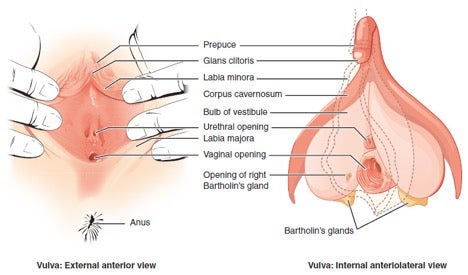
Table of Contents
What Is Insufficient Lubrication?
Insufficient lubrication, also known as vaginal dryness, is an arousal dysfunction that is characterized by soreness, itchiness, or burning of the vagina, painful intercourse, light bleeding after intercourse, or discharge that is watery, slightly discolored, or has an unpleasant smell.9,10 Vaginal dryness is considered a sexual dysfunction when it causes significant distress or interpersonal issues for the female.5 Insufficient lubrication is one of the most common sexual dysfunctions experienced by females. Approximately 17% of females aged 18 to 50 experience problems with vaginal dryness even before reaching menopause, and around 58% of post-menopausal women experience vaginal dryness.10 The consequences of vaginal dryness are far reaching both personally and within relationships. Vaginal dryness is associated in some cases with extreme discomfort and the symptoms are very similar to several sexually transmitted infections (STIs) and other medical conditions such as yeast infections and vaginitis. Even if a female is not diagnosed with one of these conditions, it can be particularly distressing to experience the symptoms, anticipate an STI or other infection, and consequently make an appointment with a healthcare professional. Furthermore, age-associated bodily changes can be hard to accept and the discomfort associated with vaginal dryness can lead to a loss in self-esteem and sexual confidence.10 Sexual difficulties can also lead to problems within their relationships, especially if a female is uncomfortable discussing the symptoms with her partner or explaining a disinterest in sexual activity or pain during intercourse. Effective communication is essential for working through any relationship issue. Additionally, having a supportive partner can decrease distress caused by vaginal dryness.
Engaging in vaginal penetration if there is insufficient lubrication can cause small tears in the vaginal tissue, thereby causing irritation and pain. Additionally, tears in vaginal tissue are open pathways for STIs to enter the blood stream, which increase her risk of contracting an STI.
What Causes Insufficient Lubrication?
Insufficient lubrication can be caused by physiological, medical, or psychological factors. Chemical irritants can change the vagina’s natural pH and irritate vaginal tissue and tissue in the surrounding areas, making the vagina feel drier. Traumatic sexual experiences can also cause vaginal dryness, among other sexual dysfunctions. Sometimes, vaginal dryness is simply caused by a lack of sufficient sexual stimulation. This section will discuss factors contributing to vaginal dryness.
Chemical Irritants
Chemicals in soaps, detergents, hygiene products, menstrual products, dyes, and other substances are potentially irritating to the sensitive tissues of the vagina and vulva. These chemicals can irritate the skin and make the vagina feel drier or cause itching or burning sensations.6 To reduce irritation caused by chemicals, the use of gentle, unscented hygiene products and unscented menstrual products is recommended. When washing fabric that will come in contact with the area, such as underwear or towels, use an unscented detergent with a gentle formula.
Condoms and personal lubricants may also contain chemicals that are potentially irritating to the vagina and could exacerbate symptoms of insufficient lubrication. Many spermicides contain the chemical nonoxynol-9 which has been shown to irritate the vaginal walls and make the tissue susceptible to small tears. If you notice any irritation after using any of the products mentioned above, discontinue use immediately and contact your healthcare professional if irritation persists.
Physiological Factors
Physiological factors that can cause vaginal dryness include hormonal changes associated with aging, pregnancy, and the post-partum period. The use of substances such as alcohol and other drugs, primarily narcotics and barbiturates, can inhibit the female sexual response as well.
One of the most common causes of vaginal dryness is a decrease in estrogen levels right before, during, and after menopause. Estrogen levels also decrease after childbirth and while a female is breastfeeding.6 The term estrogen refers to a group of chemically similar hormones. In females, the estrogenic hormones are primarily responsible for the growth and development of female sexual characteristics.7 A decrease in estrogen levels causes vulvovaginal atrophy, a condition where the tissues of the vulva and tissues lining the vagina become thinner, drier, and less elastic.8 Vaginal secretions are reduced, resulting in decreased lubrication.
Some people experiencing sexual difficulties may self-medicate with alcohol or other drugs such as narcotics or barbiturates.11 Alcohol and other drugs may help relieve anxiety about sexual activity. “Narcotic” is a general term used to encompass a variety of mind-altering substances and includes amphetamines such as cocaine or methamphetamine and opioids such as morphine or heroine. “Barbiturate” refers to a class of drugs that act a central nervous system depressant and produce sedative effects. Barbiturates have been used to treat anxiety and epilepsy, but due to the potential for physical and psychological dependence, their use has been largely phased out.11 With regular or heavy use, these drugs inhibit the sexual response and reduce libido. Studies have shown that as blood-alcohol content increases, measures of physical arousal (ie. vaginal lubrication) decrease.12 One study found that prolonged abuse of alcohol resulted in lack of lubrication in 46% of female participants.12 Despite the myth that alcohol and other drugs may act like aphrodisiacs and increase sexual function, they can actually exacerbate the symptoms of many sexual dysfunctions, including vaginal dryness.
Medical Factors
Certain medications and surgeries can also cause vaginal dryness. Allergy, common cold, and asthma medications containing antihistamines can lower moisture levels inside the body and cause reduced vaginal lubrication.6,13 Hormonal birth control methods can also contribute to vaginal dryness. Combination birth control pills, such as Lo Ovral and Ortho Cyclen, cause fluctuations in hormones that may cause vaginal dryness in some females.13 The contraceptive shot, also known by the brand name Depo-Provera, can cause changes in vaginal fluids resulting in vaginal dryness. If a female is experiencing vaginal dryness due to her birth control method, it is important that she contact her healthcare provider in order to find a new method of contraception that works for her body.
Calcium channel blockers and beta blockers have been shown to cause vaginal dryness in some females.5,13 These medications are used to treat high blood pressure and migraines by slowing the heart rate, reducing the force of heart contractions, reducing stress on the vascular system and reducing the amount of oxygen the heart needs to pump blood throughout the body.13 Reducing the heart rate and blood pressure during sexual arousal decreases blood flow to the genitals, which is one cause of vaginal lubrication prior to and during intercourse.
Some females are prescribed anti-estrogen medications to treat breast cancer. These medications suppress the growth of new breast tissue, but a decrease in estrogen can also cause vaginal tissue become thinner and drier. Lower estrogen levels can also be a side effect of chemotherapy cancer treatments.14
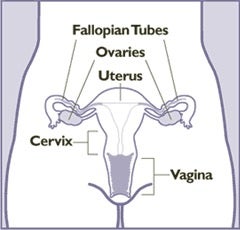
The surgical removal of both ovaries (also known as surgical menopause or oophorectomy) also causes vaginal dryness.14 The ovaries produce estrogen; therefore, the removal of both ovaries greatly reduces estrogen levels. A female might have both ovaries surgically removed when pelvic diseases such as ovarian cancer is present. Both ovaries might also be removed if the hormones produced worsen another medical condition, such as breast cancer or endometriosis.15
Medical treatments for anxiety and other mental illnesses can also cause vaginal dryness. For more information on how mental illnesses can cause insufficient lubrication, please see the section titled “Psychological Factors.”
Psychological Factors
Anxiety and other mental illnesses can interfere with a female’s sexual arousal response and in some cases, medications used to treat these disorders have been associated with reduced vaginal lubrication. Stress and anxiety are normal physiological responses to environmental stimuli that are perceived as dangerous. Anxiety disorders are characterized by abnormally high levels of nervousness and anxiousness in the absence of stressful stimuli.16 Anxiety is associated with an overactive sympathetic nervous system, which naturally inhibits arousal.17 During arousal, anxiety can distract from erotic stimulation which results in reduced lubrication in females.
Antidepressant medications can also cause vaginal dryness. Antidepressants are used to treat a variety of conditions in addition to depression, including anxiety disorders, eating disorders, obsessive compulsive disorders, and chronic pain, among others. There are many different kinds of antidepressants such as tricyclic antidepressants, selective serotonin reuptake inhibitors (SSRIs), dopamine antagonists, and monoamine oxidase inhibitors (MAOIs). Although the exact mechanism by which antidepressants cause sexual dysfunctions is unknown, it is likely because they block the action of neurotransmitters in the brain. Neurotransmitters are chemicals that allow nerve cells in the brain to communicate with each other.18 If you are taking antidepressants and are experiencing reduced lubrication as a side effect of your medication, do not stop taking your medication. Please consult your healthcare provider about options to decrease the side effects.
Factors Related to a Traumatic Sexual Experience
Females who have experienced sexual violence in childhood or adulthood are more likely to develop a sexual dysfunction and have difficulties with intimate relationships.5 The World Health Organization defines sexual violence as any coerced or non-consensual sexual act, involving any sexual act, attempt of a sexual act, sexual comments, or acts directed against a persons’ sexuality using coercion, by any person regardless of their relationship to the survivor.19 The most common sexual disturbances reported by females who have experienced sexual violence is fear of sex, arousal dysfunctions, and desire dysfunctions. One study found that females who have survived sexual violence reported reduced lubrication after the assault. Additionally, the same study reported that desire, arousal, lubrication, and overall satisfaction significantly decreased with increasing severity of the assualt.19 There is also significant research suggesting that female survivors of sexual violence filter sexual experiences through negative self and sexual schemas and therefore experience negative emotions such as guilt, disgust, regret, and shame during sexual arousal.19 A schema refers to a pattern of thought an individual uses to organize information. In this context, negative schemas about the self and sexuality stem from feelings of shame and a violation of trust that is associated with previous sexual abuse.19 The resulting negative reaction to sexual activity make it hard for survivors to view themselves as sexual beings and essentially eliminates the positive effects of appropriate sexual functioning.
Survivors of sexual violence are also at a higher risk of developing depression, anxiety, or substance abuse disorders which can worsen issues with insufficient lubrication. Females who experience vaginal dryness as a result of sexual violence need a more comprehensive treatment plan that will address unresolved trauma.5
Other Risk Factors

Smoking, no vaginal births, and lack of sexual activity are associated with vaginal dryness.14 Cigarette smoking affects blood circulation and may cause vaginal tissue to not get enough oxygen, decreasing moisture levels and elasticity. Smoking also reduces the effects of naturally occurring estrogen in the body and females who smoke reach menopause earlier than non-smoking females. Studies have also found that females who have not given birth vaginally are more likely to develop symptoms of insufficient lubrication than females who have delivered vaginally. A lack of sexual activity also contributes to vaginal dryness because sexual activity, with or without a partner, increases blood flow to the vagina which keeps vaginal tissues elastic.14
Treatment of Insufficient Lubrication
The good news is that there are a variety of treatment options for females who experience vaginal dryness. Treatments are chosen and modified based on the cause of insufficient lubrication and will vary from female to female. Treatments range from increased time spent on foreplay and sexual stimulation, to use of personal lubricants, to hormone therapy.
Increased Foreplay
Sometimes the cause of insufficient lubrication (and consequently painful intercourse) is a lack of sufficient arousal. Before any sexual contact, it is extremely important for partners to communicate to each other what feels good and what may be uncomfortable. Both partners must consent with an enthusiastic “Yes!” before sexual contact begins. It is important to remember that consent can be revoked at any time, and what feels good for one person may not feel good to another. Establishing consent and an open line of communication is especially important for survivors of sexual assault.
Once consent has been given, partners can begin discovering what stimulation feels best. Partners can increase arousal by spending more time on foreplay. Foreplay refers to any type of sexual activity that increases arousal. Foreplay can start with flirting or exchanging sexy text messages or images, also called sexting. Some partners prefer to start with touching in non-genital areas by giving a massage or by showering together. Foreplay also includes manual or oral genital stimulation. A sensual massage is a great way to start touching your partner and build up sexual excitement and anticipation. The key to increasing arousal with foreplay is to slow down and take your time. Since every female body is different, partners will need to communicate with each other about what type of stimulation feels best. Some females prefer more pressure while others prefer a more gentle touch.
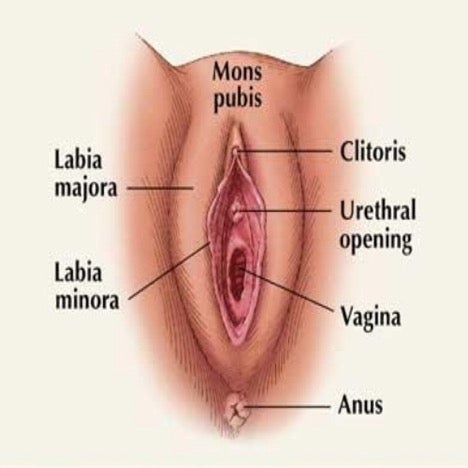
Some prefer direct clitoral stimulation and others find direct stimulation of the clitoris uncomfortable and prefer stimulation of areas around the clitoris. The clitoris is the most sensitive part of the vulva. Oral stimulation, also called cunnilingus or “eating out,” involves a partner using their mouth to stimulate the clitoris and surrounding areas of the vulva, including the mons, the vaginal opening, and the inner and outer labia. Before focusing directly on the clitoris, it is a good idea to begin by exploring the receiving female’s body by lightly kissing, licking, or sucking on her upper thighs and stomach and the area around her vulva to get her aroused. Arousal takes time and adequate lubrication may not come immediately.
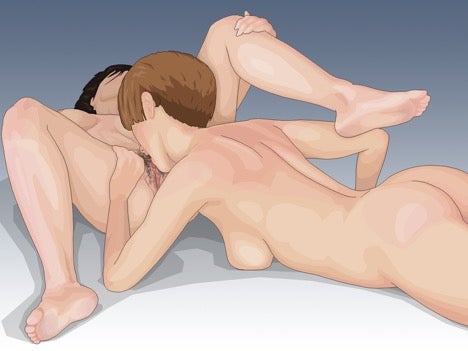
Oral sex has the added benefit of saliva, which can be used as a lubricant and make receiving oral sex more comfortable. If a female is experiencing vaginal dryness and a lack of lubrication, saliva alone is usually not enough lubrication for vaginal penetration. Before inserting a finger, penis, or other object, be sure there is enough lubrication present.
Some females find a combination of oral and manual stimulation extremely pleasurable and some partners choose to use a vibrator or other sex toy. Vibrators are used to stimulate of the vulva and clitoris which increases blood flow to the area, increasing vaginal lubrication. Introducing sex toys or incorporating novel ideas into sexual activity may also increase arousal. Some partners find sexual fantasy role play incredibly fun and exciting. Role play is where partners dress up in a costume and play into some kind of characters or roles. Some people find that role play allows them to be more sexually dominant or submissive than they would usually be, which can be an exhilarating and arousing experience. Others find that having sex in a novel location, such as in the kitchen, in the car, or out in a safe, public location, is an exciting way to increase arousal. Getting away with having sex in a new, exciting place or a place where you should not be having sex can be especially arousing. For more information on ideas to spice up your sex life, please see our article “Fun and Sexy Games.”
It is important to recognize that sometimes foreplay and sexual stimulation alone are not enough to treat insufficient lubrication and there is nothing wrong with that! Females who experience low levels of lubrication can still have very satisfying sex lives. Be kind to your body and give yourself time to try different treatments until you find one that works for you.
Personal Lubricants
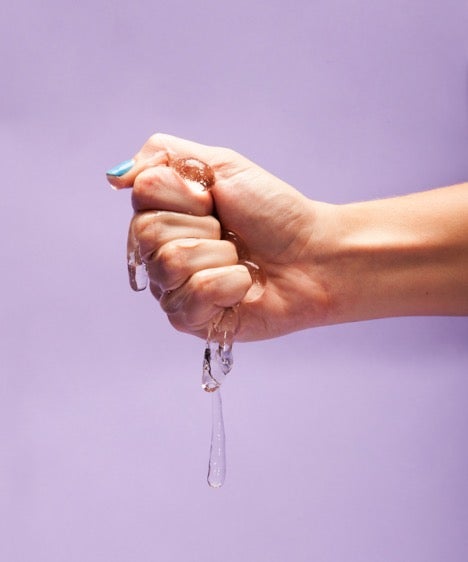
Many females find that the addition of a personal lubricant during sexual activity is extremely pleasurable, whether or not they experience vaginal dryness. Lubricants, commonly called “lube,” increase comfort and pleasure during penetration by decreasing friction between body parts. People use lubricant to make sexual activity more comfortable with a partner, when masturbating, or when using a sex toy. There are a variety of different types of lubricants made from a wide range of ingredients. Some are flavored to enhance oral sex and some have a warming or tingling sensation to enhance vaginal or clitoral stimulation. Water-based lubricants are the most commonly used lubricants. They have a tendency to dry out but can be reapplied as needed. Silicone based lubricants can be used as well and do not dry out as quickly. All of us here at SexInfo recommend using a water- or silicone-based lubricant because they can be used safely with condoms, as any oil-based product will severely damage the product. Please note that personal lubricants do not prevent pregnancy nor do they protect against sexually transmitted infections.
Hormone Therapy
When estrogen levels start decreasing in the body, replacing them with a hormone therapy treatment can ease the uncomfortable side effects such as reduced lubrication. Estrogens work in part by increasing a normal, clear discharge from the vagina and keeping the tissues of the vulva healthy.20 Estrogen can be applied as a cream to the vagina and vulva, used as a vaginal suppository, or taken by mouth. When estrogen is applied to the vulva or vagina or inserted as a suppository, the hormone is absorbed through the skin and enters the bloodstream.20
Estrogen medications may not be right for everyone. It is not recommended for females who are pregnant or breastfeeding. Females who are over the age of 65 have an increased risk of experiencing side effects from the treatments such as stroke, breast cancer, and memory problems.20 When discussing using estrogens with your healthcare provider, be sure to disclose any allergies to medications or any medications currently being taken. Estrogen treatments can only be obtained through with a prescription. If you are a female experiencing vaginal dryness, contact your healthcare provider and discuss whether or not estrogen treatments are right for you.
Concluding Remarks
Painful intercourse due to insufficient lubrication can be distressing for a female however we want to emphasize that successful treatment plans exits. If you or your partner is experiencing symptoms of vaginal dryness, work within your relationship or with a healthcare provider to establish a treatment plan that works. Sometimes, it is as simple as spending more time on foreplay! For more information about sex, health, and relationships, explore our homepage. If you have any questions, feel free to Ask the Sexperts.
References
- “Sexual Health Q&A: Why is vaginal lubrication important for women?” ISSM.info. International Society for Sexual Medicine, n.d. Web. 13 Oct. 2017.
- Levin, Roy J. “The Ins and Outs of Vaginal Lubrication.” Sexual and Relationship Therapy, vol. 18, no. 4, 2003. Web. 13 Oct. 2017.
- Nilson, Richard. “Where Does Natural Vaginal Lubrication Come From?” LiveStrong.com. Livestrong.com. 14 Aug. 2017. Web. 13 Oct. 2017.
- Castellanos, Madeleine M. “Natural Lubrication in Women.” TheSexMD.com. The Sex MD: Madeleine M Castellanos, MD. n.d. Web. 15 Oct. 2017.
- Vermillion, Stephen T. and Melissa Holmes. “SEXUAL DYSFUNCTION IN WOMEN.” Primary Care Updates for OB/GYNS, vol. 4, no. 6, 1997. Web. 15 Oct. 2017.
- Lee, Katherine. “5 Things That Can Cause Vaginal Dryness.” EverydayHealth.com. Everyday Health Media, LLC. 12 April 2016. Web. 15 Oct. 2017.
- Manson, JoAnn E. “Estrogen.” HealthyWomen.org. National Women’s Health Resource Center, Inc. n.d. Web. 15 Oct. 2017.
- “Changes in the Vagina and Vulva.” Menopause.org. The North America Menopause Society. n.d. Web. 15 Oct. 2017.
- Stoppler, Melissa C. “Vaginal Dryness and Vaginal Atrophy.” MedicineNet.com. MedicineNet, Inc. 9 Sept. 2016. Web. 15 Oct. 2017.
- “Vaginal Dryness.” Womens-Health-Concern.org. British Menopause Society. Aug. 2017. Web. 15 Oct. 2017.
- Ogbru, Omudhome. “Barbiturates.” MedicineNet.com. MedicineNet, Inc. 6 Feb. 2017. Web. 15 Oct. 2017.
- Peugh, Jordon and Steven Belenko. “Alcohol, Drugs, and Sexual Function: A Review.” Journal of Psychoactive Drugs, vol. 33, no. 3, 2011. Web. 15 Oct. 2017.
- Cornforth, Tracee. “Medications That Cause Vaginal Dryness.” VeryWell.com. VeryWell. 11 March 2017. Web. 16 Oct. 2017.
- “Vaginal Atrophy.” MayoClinic.org. Mayo Foundation for Medical Education and Research. 4 Aug. 2017. Web. 16 Oct. 2017.
- Marshall, Sarah and Kirtly Jones. “Oophorectomy – Topic Overview.” WebMD.com. WebMD, LLC. 12 March 2014. Web. 16 Oct. 2017.
- Parekh, Ranna. “What Are Anxiety Disorders?” Psychiatry.org. American Psychiatric Association. Jan. 2017. Web. 16 Oct. 2017.
- Coretti, Giorgio and Irene Baldi. “The Relationship Between Anxiety Disorders and Sexual Dysfunction.” PsychiatricTimes.com. UBM Medica Network. 1 Aug. 2007. Web. 16 Oct. 2017.
- Neel, Armon B. “7 Meds That Can Wreck Your Sex Life.” AARP.org. American Association of Retired Persons. n.d. Web. 16 Oct. 2017.
- Mohammed, Ghada F. and Rania K.H. Hashish. “Sexual Violence Against Females and Its Impact on Their Sexual Function.” Egyptian Journal of Forensic Sciences, vol. 5, no. 3, September 2015. Web. 16 Oct. 2017.
- “Estrogen (Vaginal Use).” MayoClinic.org. Mayo Foundation for Medical Education and Research. 1 March 2017. Web. 17 Oct. 2017.
Last updated: 27 November 2017.
